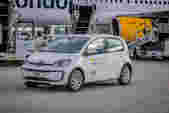Climate protection
Our climate protection strategy
The Central German airports have defined the following main areas for action in their climate protection strategy:
- completely switching to green electricity and compensating for emissions that are created by using natural gas (this has already been taking place since 2020)
- increasing the energy efficiency of the airport infrastructure
- switching the airports’ own vehicles and machines to alternative drive systems
- introducing high energy efficiency standards when planning facilities and new buildings
The Central German airports have a mission: zero emissions – whether this means climate-neutral heat generation, electric vehicles or using energy-saving technologies.
REDUCING CO2 EMISSIONS
The Central German airports are purchasing climate-friendly energy.
The Central German airports have been purchasing green electricity since 2020 and have therefore reduced their CO2 emissions by at least 6,000 tonnes per annum. An annual equivalent of approx. 8,000 tonnes of CO2 is compensated for by purchasing certificates for the CO2 emissions from natural gas, which is particularly used to operate the combined heat and power station and heat the buildings at Leipzig/Halle Airport.
Thanks to purchasing CO2-neutral energy and compensating for CO2 emissions from natural gas, we have significantly reduced our CO2 emissions. As a result, we are already significantly exceeding the sector objective of reducing emissions by more than 65 percent compared to 2010 – the goal that has been set for introduction at German commercial airports by 2030.
Switching the vehicle fleet to alternative drive systems
We believe that developing our vehicle and machine fleet to use alternative drive systems is an effective tool in order to reduce CO2 emissions in the long term. Our vehicle fleet currently has more than 120 vehicles operating with alternative drive systems.
They include electrically-powered
- baggage tugs, conveyor belts and passenger steps, which are used on the apron area when handling aircraft
- pushback vehicles,
- high loaders and service vehicles.

Innovations

When using emission-neutral vehicles, we are committed to introducing innovations and have completed the in-house conversion work to install an electrical drive system in two fresh-water vehicles.
Technicians at Dresden Airport converted one fresh-water vehicle from an internal combustion engine to an electrical drive system for the first time in 2019. As there were still not any suitable vehicles of this type available on the market at this time, the airport needed its own solution. The change of drive system took about two-and-a-half months. The second vehicle followed one year later.
The German Federal Ministry of Finance, which provided subsidies for the conversion work through its Funding Programme for Electric Mobility, supported this project.
PortGround, a subsidiary of Mitteldeutsche Flughafen AG, now makes use of the converted fresh-water vehicles. In addition to preventing approx. 2 tonnes of CO2 emissions per year, the zero-emission vehicles also provide benefits in terms of health and safety at work.
With a range of about 50 kilometres and a charging time of roughly one hour, the vehicles are proving to be a success story in daily operations on the apron areas.
Energy management

Thanks to their energy management system that is certified in line with DIN EN ISO 50001, the Central German airports are continually increasing energy efficiency levels at both the sites.
The Central German airports are preventing about 670 tonnes of CO2 emissions every year by switching the lighting to LED technology in the multi-storey car parks, the airport buildings, on the apron areas and in the outside areas next to the terminals.
The goal of reducing emissions is also being considered when planning and constructing new facilities and buildings. This is taking place by means of consistently using high energy efficiency standards.